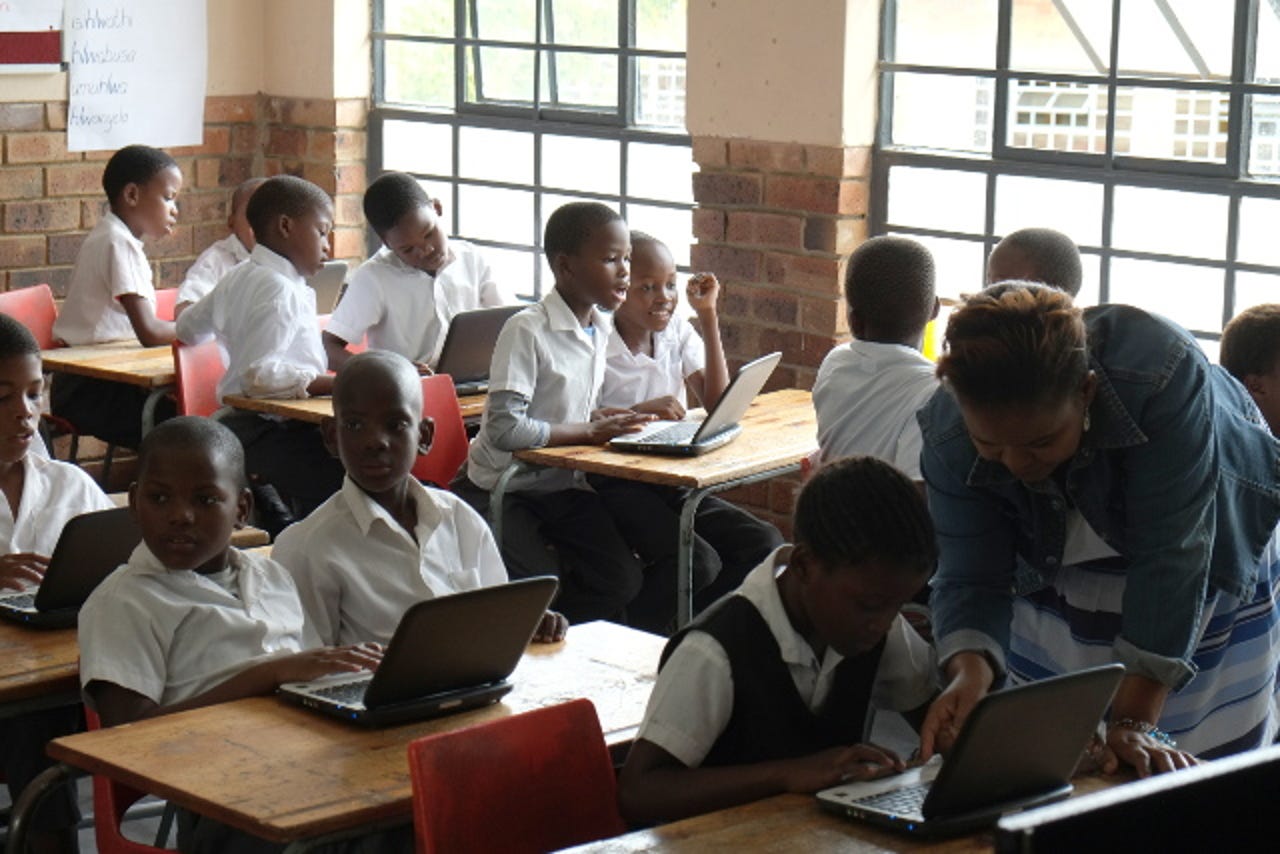After OLPC, does IT in education have a future?

Welcome reaches over to the mouse pad and moves to select the picture of a smiling farmer from the top of the screen. Moeketsi slaps her hand away and uses the track pad to move the sprite down, placing the image next to the sentence: "I water the plant every day."
The two nine-year-old girls smile in celebration as the image slots into place, then move on to the next challenge in their virtual workbook. They're studying English: First Additional Language in the manner of students at schools all over South Africa.
What makes it unusual is that this class is in Muzomuhle Primary School in Diepsloot, a sprawling informal settlement to the north of Johannesburg where access to IT is a distant priority behind basic sanitation, electricity and water.
Diepsloot is home to somewhere between a quarter to a half a million people, of whom somewhere between 50 percent and 80 percent are out of work, depending which statistics you read. It regularly hits the headlines due to high levels of violent crime and outbreaks of vicious xenophobic attacks on foreign-owned stores, but as with most places characterised by extreme poverty, life in Diepsloot is a lot more complex than it outwardly appears: but the fact is that access to computers here — just a few kilometres from the African HQs of Microsoft, Sage, SAP, Samsung et al — is rare.
Welcome and Moeketsi, however, are part of a nationwide pilot program being co-ordinated by Intel and the department of basic education to evaluate the most effective way of deploying computers in primary schools.
"We decided to use the computers with our grade 3 classes rather than our older children because we don't have the skills to teach computer sciences here," principal John Ramarumo said, "so we wanted to focus instead on exposing them to IT as soon as early as possible, even if they do not use it for a few years, the foundations have been set."

The pilot began in November, when Muzomuhle was given a large wheeled cabinet with 22-built in charging stations for the same number of laptops. It's designed for schools such as this — it can be locked up in the safe room overnight, and moved from classroom to classroom as required. Typically, schools have previously been provided with computer labs, but securing a whole new room is tricky, and theft is a big issue.
Ramarumo says that he has noticed almost immediate benefits.
"The biggest change has been in learning English," he said. "Up to grade 3, learners are taught in their home language, but from grade 4 [the national curriculum] requires that they are taught in English — and that can be a difficult transition. With the computers, the children enjoy using them and because everything is in English, they are learning and building confidence without realising."
Muzomuhle is exactly the kind of school that must have been in Nicholas Negroponte's mind when he launched the One Laptop Per Child project in 2005. And it's also exactly the kind of place which probably explains why recently rumours started to swirl that the project was winding down.
OLPC still exists, according to vice president of business development Giulia D'Amico, and will focus on software development. It's potentially a smart move — tablet computers that cost less than $100 are commonplace now and in South Africa, at least, it's relatively easy to find a business that will donate a box of low-cost computers to underprivileged schools in order to meet its corporate social responsibility obligations.
Core, the local Apple distributor, has a special bundle of iPads and flight cases it sells just for this purpose.
While the idea of a $100 laptop once seemed outlandish, now the goal of distributing hardware is recognised as only part of the challenge and may even have been counter-productive. Dr Anna Wertlen, an academic in the Eastern Cape, says that she co-founded the non-profit organisation awareNet because of an influx of poorly-planned IT initiatives in the area.
awareNet designs software and low cost mesh networks for disadvantaged schools in the Grahamstown area, helping pupils and teachers to make use of IT equipment for learning and educational networking.
"We work together with schools that had a computer lab dumped on them without any teacher workshops, suitable software or internet," Wertlen said, "which often happens, either by foreigners or the government."
Teachers at Muzomuhle say that they have had some training, but more is definitely required. Pedagologically sound software which caters for local needs, however, is thin on the ground and virtually non-existent in languages other than English.
In order to stay within the requirements of South Africa's national curriculum — the Curriculum Assessment Policy Statements (CAPS) — the software currently used by Welcome and Moeketsi is simply an interactive version of workbooks given to pupils at the start of the year. This can lead to problems in the classroom — they struggle to draw pictures of farm animals using the mouse pad as requested in one exercise, a task which would challenge any professional artist. The transfer of a paper-based challenge to screen simply doesn't work — but the frustration doesn't seem to make it much less enjoyable for the children.
Ultimately, though, the winning argument for technology in underprivileged schools may yet come down to cost — exactly the original argument for OLPC. At a government-run school on the other side of Johannesburg, teachers have pushed an experiment with technology to its logical conclusion.
Sunward Park is a 'model C' secondary school in which not all textbooks are provided by the state. After receiving sponsorship from a local business in 2010, Sunward purchased a case of tablets to share among its classes similar to that in Muzomuhle.
It was a project plagued with problems, however, as teachers struggled to use the hardware, the first two wi-fi networks installed were unreliable and class leaders soon lost faith to the point that the tablets were mostly unused.
In 2013, however, the school took the bold step of going digital-only. All pupils — most of who are from the nearby townships — are now required to buy an Android tablet in order to study at Sunward.
The school maintains a list of recommended suppliers, and the average cost is between R1,000 and R2,000 ($90-180) per machine. Previously, parents were required to spend around R1,800 ($165) a year on textbooks. Now the same books are available digitally for R300 ($28) a year. With instalment plans available to spread the cost, parents have been overwhelmingly supportive of the move.
At the end of the first year, school leavers achieved a 98 percent pass rate in the matriculation exam, and one learner achieved the eighth highest for the Gauteng region. Admittedly, it was off of a high base — Sunward has scored well in matriculation tests outperforming far richer schools for a few years — but deputy principle Enoch Thango says that he cautiously sees this as a vindication of their decision to go digital.
As far as Muzomuhle is concerned, however, it's just one of 1,650 primary schools across the country where the Department of Basic Education (DBE) is trialling the mobile computer units. The department says it will have finished the first phase of the trial by the end of this month, and hopes to have an audited report by mid-year, which will help it to allocate budgets for 2015. What happens next academic year remains to be seen.